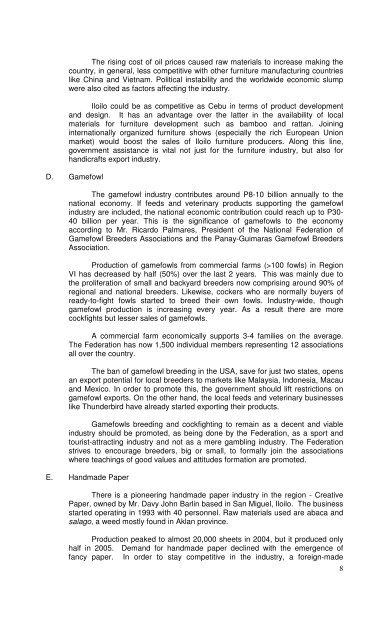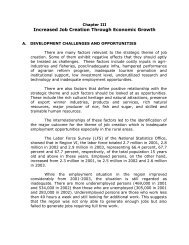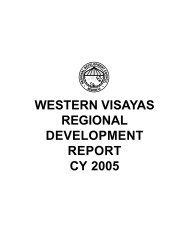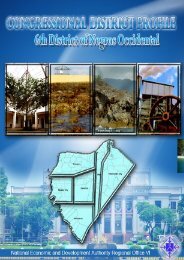REGIONAL ECONOMIC SITUATIONER Western ... - NEDA-RDC VI
REGIONAL ECONOMIC SITUATIONER Western ... - NEDA-RDC VI
REGIONAL ECONOMIC SITUATIONER Western ... - NEDA-RDC VI
Create successful ePaper yourself
Turn your PDF publications into a flip-book with our unique Google optimized e-Paper software.
The rising cost of oil prices caused raw materials to increase making the<br />
country, in general, less competitive with other furniture manufacturing countries<br />
like China and Vietnam. Political instability and the worldwide economic slump<br />
were also cited as factors affecting the industry.<br />
Iloilo could be as competitive as Cebu in terms of product development<br />
and design. It has an advantage over the latter in the availability of local<br />
materials for furniture development such as bamboo and rattan. Joining<br />
internationally organized furniture shows (especially the rich European Union<br />
market) would boost the sales of Iloilo furniture producers. Along this line,<br />
government assistance is vital not just for the furniture industry, but also for<br />
handicrafts export industry.<br />
D. Gamefowl<br />
The gamefowl industry contributes around P8-10 billion annually to the<br />
national economy. If feeds and veterinary products supporting the gamefowl<br />
industry are included, the national economic contribution could reach up to P30-<br />
40 billion per year. This is the significance of gamefowls to the economy<br />
according to Mr. Ricardo Palmares, President of the National Federation of<br />
Gamefowl Breeders Associations and the Panay-Guimaras Gamefowl Breeders<br />
Association.<br />
Production of gamefowls from commercial farms (>100 fowls) in Region<br />
<strong>VI</strong> has decreased by half (50%) over the last 2 years. This was mainly due to<br />
the proliferation of small and backyard breeders now comprising around 90% of<br />
regional and national breeders. Likewise, cockers who are normally buyers of<br />
ready-to-fight fowls started to breed their own fowls. Industry-wide, though<br />
gamefowl production is increasing every year. As a result there are more<br />
cockfights but lesser sales of gamefowls.<br />
A commercial farm economically supports 3-4 families on the average.<br />
The Federation has now 1,500 individual members representing 12 associations<br />
all over the country.<br />
The ban of gamefowl breeding in the USA, save for just two states, opens<br />
an export potential for local breeders to markets like Malaysia, Indonesia, Macau<br />
and Mexico. In order to promote this, the government should lift restrictions on<br />
gamefowl exports. On the other hand, the local feeds and veterinary businesses<br />
like Thunderbird have already started exporting their products.<br />
Gamefowls breeding and cockfighting to remain as a decent and viable<br />
industry should be promoted, as being done by the Federation, as a sport and<br />
tourist-attracting industry and not as a mere gambling industry. The Federation<br />
strives to encourage breeders, big or small, to formally join the associations<br />
where teachings of good values and attitudes formation are promoted.<br />
E. Handmade Paper<br />
There is a pioneering handmade paper industry in the region - Creative<br />
Paper, owned by Mr. Davy John Barlin based in San Miguel, Iloilo. The business<br />
started operating in 1993 with 40 personnel. Raw materials used are abaca and<br />
salago, a weed mostly found in Aklan province.<br />
Production peaked to almost 20,000 sheets in 2004, but it produced only<br />
half in 2005. Demand for handmade paper declined with the emergence of<br />
fancy paper. In order to stay competitive in the industry, a foreign-made<br />
8








